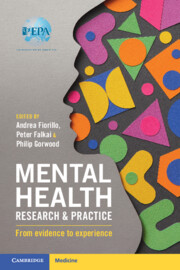152 results
Physical activity and treatment adherence in patients with mental disorders: a randomized controlled trial
-
- Journal:
- European Psychiatry / Volume 67 / Issue S1 / April 2024
- Published online by Cambridge University Press:
- 27 August 2024, pp. S63-S64
-
- Article
-
- You have access
- Open access
- Export citation
Sport-based psychosocial interventions for people suffering from severe mental disorders: EASMH pilot actions from 4 European Countries
-
- Journal:
- European Psychiatry / Volume 67 / Issue S1 / April 2024
- Published online by Cambridge University Press:
- 27 August 2024, p. S54
-
- Article
-
- You have access
- Open access
- Export citation
Does duration of untreated illness impact long-term outcome in obsessive-compulsive disorder?
-
- Journal:
- European Psychiatry / Volume 67 / Issue S1 / April 2024
- Published online by Cambridge University Press:
- 27 August 2024, pp. S355-S356
-
- Article
-
- You have access
- Open access
- Export citation
How to manage work-related stress in healthcare professionals: organizational and individual interventions.
-
- Journal:
- European Psychiatry / Volume 67 / Issue S1 / April 2024
- Published online by Cambridge University Press:
- 27 August 2024, p. S600
-
- Article
-
- You have access
- Open access
- Export citation
A study on the complex interplay between inflammation and severe mental disorders (SMInflam)
-
- Journal:
- European Psychiatry / Volume 67 / Issue S1 / April 2024
- Published online by Cambridge University Press:
- 27 August 2024, p. S684
-
- Article
-
- You have access
- Open access
- Export citation
The improvement of mental and physical health of people with severe mental disorder: one-year efficacy of a lifestyle experimental intervention
-
- Journal:
- European Psychiatry / Volume 67 / Issue S1 / April 2024
- Published online by Cambridge University Press:
- 27 August 2024, pp. S53-S54
-
- Article
-
- You have access
- Open access
- Export citation
Climate change and mental health: Position paper of the European Psychiatric Association
-
- Journal:
- European Psychiatry / Volume 67 / Issue 1 / 2024
- Published online by Cambridge University Press:
- 23 May 2024, e41
-
- Article
-
- You have access
- Open access
- HTML
- Export citation
Clinician treatment choices for post-traumatic stress disorder: ambassadors survey of psychiatrists in 39 European countries
-
- Journal:
- European Psychiatry / Volume 67 / Issue 1 / 2024
- Published online by Cambridge University Press:
- 07 March 2024, e24
-
- Article
-
- You have access
- Open access
- HTML
- Export citation
Index
-
- Book:
- Mental Health Research and Practice
- Published online:
- 01 February 2024
- Print publication:
- 08 February 2024, pp 393-404
-
- Chapter
- Export citation
Contents
-
- Book:
- Mental Health Research and Practice
- Published online:
- 01 February 2024
- Print publication:
- 08 February 2024, pp v-vi
-
- Chapter
- Export citation
Preface
-
- Book:
- Mental Health Research and Practice
- Published online:
- 01 February 2024
- Print publication:
- 08 February 2024, pp xiii-xiv
-
- Chapter
- Export citation
Copyright page
-
- Book:
- Mental Health Research and Practice
- Published online:
- 01 February 2024
- Print publication:
- 08 February 2024, pp iv-iv
-
- Chapter
- Export citation
Contributors
-
- Book:
- Mental Health Research and Practice
- Published online:
- 01 February 2024
- Print publication:
- 08 February 2024, pp vii-xii
-
- Chapter
- Export citation

Mental Health Research and Practice
- From Evidence to Experience
-
- Published online:
- 01 February 2024
- Print publication:
- 08 February 2024
Psychosocial interventions for carers of people with severe mental and substance use disorders: a systematic review and meta-analysis
-
- Journal:
- European Psychiatry / Volume 66 / Issue 1 / 2023
- Published online by Cambridge University Press:
- 24 November 2023, e98
-
- Article
-
- You have access
- Open access
- HTML
- Export citation
The future of diagnosis in clinical neurosciences: Comparing multiple sclerosis and schizophrenia
-
- Journal:
- European Psychiatry / Volume 66 / Issue 1 / 2023
- Published online by Cambridge University Press:
- 21 July 2023, e58
-
- Article
-
- You have access
- Open access
- HTML
- Export citation
Comorbidity between physical illness, infection diseases and mental disorders
-
- Journal:
- European Psychiatry / Volume 66 / Issue S1 / March 2023
- Published online by Cambridge University Press:
- 19 July 2023, p. S13
-
- Article
-
- You have access
- Open access
- Export citation
The impact of COVID-19 pandemic on the healthcare workers mental health
-
- Journal:
- European Psychiatry / Volume 66 / Issue S1 / March 2023
- Published online by Cambridge University Press:
- 19 July 2023, pp. S413-S414
-
- Article
-
- You have access
- Open access
- Export citation
Antenatal depression, obstetric outcomes, and post-partum depression: results from a longitudinal, real-world study
-
- Journal:
- European Psychiatry / Volume 66 / Issue S1 / March 2023
- Published online by Cambridge University Press:
- 19 July 2023, pp. S501-S502
-
- Article
-
- You have access
- Open access
- Export citation
Improving sport-based psychosocial interventions in Europe: results from the EASMH training programme for professional sport coaches
-
- Journal:
- European Psychiatry / Volume 66 / Issue S1 / March 2023
- Published online by Cambridge University Press:
- 19 July 2023, pp. S312-S313
-
- Article
-
- You have access
- Open access
- Export citation

